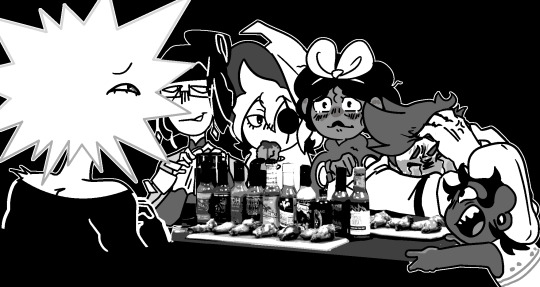#Black Sauce
Explore tagged Tumblr posts
Text
Went to the Kopitiam Food Court at Sembawang MRT Station for an early dinner and decided to try this noodle stall I have not eaten from before. Picked the Premium Chicken Cutlet Noodle (特制鸡扒面) with black sauce and a side of Prawn Rolls (虾卷). Both dishes cost the same at S$5.50 each. The savoury and springy noodles were good though the chicken cutlet isn’t that premium at all. The same goes for the average tasting prawn rolls with barely prawn flavour in it.



#Kopitiam#Food Court#Sembawang MRT Station#Premium Chicken Cutlet Noodle#特制鸡扒面#Black Sauce#Crispy Chicken#Thin Yellow Noodles#Mee Kia#Dry-Style#Prawn Rolls#虾卷#Chilli Sauce#Chinese Cabbage#Xiao Bai Cai#Soup#Dinner#Food#Buffetlicious
55 notes
·
View notes
Text


MEDIEVAL BOAR WITH BLACK SAUCE (1553)
I will be travelling for about a month at Christmastime (see you soon, Japan and Australia!), so I have to get a start on some Christmas-themed Tasting History dishes a little early - this time: Boar with Black Sauce, a medieval German recipe for boar's head from Das Kochbuch der Sabina Welserin, by Sabina Welserin and published in 1553 (though the recipe itself is older). Because I couldn't get my hands on a boar's head (and neither could Max), the recipe used here has been simplified a little. For hundreds of years, Christmas has been a time for feasting and eating foods considered to be a special treat. In medieval Europe, some of those Christmas feasts began with an impressive boar’s head: the head was hollowed out and stuffed with other meat, fruit, and spices, then boiled, and finally paraded into the room alongside other savoury dishes. In medieval England, this was also the case, until boar were over-hunted and hard to come by. This wouldn't deter the English however. Instead, they used a pig’s head with tusks added, or a pie or cake in the shape of a boar’s head. Boar's head is even still prepared for Christmastime today in some cases, like at the Boar's Head Gaudy at Queen's College Oxford. It ain't Christmas without a boar's head, after all. I chose to make this pared down version of Boar's Head with Black Sauce in order to experience the festive flavours of medieval Europe, as well as take a second shot at cooking boar after a less than stellar first attempt (I'm looking at you, Templar Boar with Cameline Sauce...). See Max’s video on how to make this dish here or see the ingredients and process at the end of this post, sourced from his website.
My experience making it:
Since I unsurprisingly could not source a boar's head, I settled on boar backstrap rather than Max's choice of boar shoulder. For the red wine, used for cooking the boar, the sauce, and in our glasses, I used a Médoc red, a lovely gift from a French friend (merci Adélaide!). I omitted the almonds, since I am not a big fan of them, and instead added a little more of the raisins and granny apple. I used red grapes in the sauce. I absolutely scoured my city looking for a cherry syrup without any additives, but emerged fruitless (hehe...), so I just used a basic brand cherry syrup with the only extra ingredient being lemon juice. Also, since I don't have an oven-safe frying pan and lid, I just transferred between a normal frying pan and a casserole dish with tinfoil for a 'lid' - this worked just fine.
I preheated the oven, then prepared my ingredients. After mixing together the dry rub spices, I massaged them into the boar, then fried the meat in schmalz on each side until it was lightly browned. I then transferred the meat to a casserole dish, being sure to add all juices from the bottom, added in the wine, quickly covered it with tinfoil, and put it in the oven. I used a slightly lower temperature than Max, since he used quite a large boar shoulder, and my boar backstrap was small and thin. While this cooked for a few hours, I prepared my sides (fried potatoes and peas, something easy) and my black sauce. I added some schmalz to the pot, then added what I thought was whole-wheat flour, mixing vigourously to try and turn it into a roux. This did not go as planned. I had used German Vollkornmehl, which I thought was supposed to be the same, but it had quite large chunks, it did not seem to combine at all. I decided to continue following the recipe as stated, but if the sauce didn't thicken, I would add a roux using all-purpose white flour at the end to bring it to the right consistency. I added the wine, cherry syrup, spices, raisins, and grapes according to the recipe, the latter cut in half in order to hopefully impart their juices. At this point, I took the boar out and let it cool on a homemade tinfoil rack. After simmering the black sauce for more than 10 minutes, the sauce was still not thickening, so I enacted my Plan B and added a roux with all-purpose flour. This worked a charm! The black sauce became a gravy-like consistency (although I know this is not as historically accurate in terms of method). I sliced the boar, drizzled it with the black sauce, and surrounded it with raisins and diced apples. It looked divine - definitely one of the more deluxe dishes I have made in terms of presentation. I served it forth on a plate in order to portion out at the table to join the potatoes and peas. I poured what was left of the wine into a small glass each for my husband and I.
My experience tasting it:
I cut a piece of boar with black sauce on it and made sure there was a raisin, a piece of grape, and a chunk of apple on top. While the texture of the boar was still not great (boar may just be my white whale), the flavours of the sauce, apple, and raisins went together so nice with the meat! The sauce itself tasted almost identical to a German glühwein - which in my opinion is a great feat. The grapes, all mushy from the sauce, gave a nice soft texture to counter the kind of dry meat, and the apple a lovely crisp crunch. While the sauce went great on meat, my preference would definitely be to put it on a dessert, like ice cream, strudel, or germknödel. I would also consider adding a few other glühwein-like ingredients to the sauce, like cinnamon or lemon/orange zest. Whether enjoyed sweet or savoury, this sauce is quite wonderful, and my husband and I have decided to keep the recipe for it. I can't say the same for what I thought was supposed to be the star of this dish: the boar. While it tasted a little more tender than the last time I made boar, it was still fairly dry and underwhelming. Maybe you really do have to make the whole boar head in order to impress! If you end up making this dish, if you liked it, or if you changed anything from the original recipe, do let me know!
Medieval Boar with Black Sauce original recipe (1796)
Sourced from Das Kochbuch der Sabina Welserin by Sabina Welserin (1553).
Seasoned well with pepper, ginger and a little cloves, nutmeg and saffron… laid on a grate and basted with wine… Afterwards make a black… sauce with it. First… you should heat up a little fat and brown a small spoonful of wheat flour in the fat and after that put good wine into it and good cherry syrup, so that it becomes black, and sugar, ginger, pepper, cloves, and cinnamon, grapes, raisins and finely chopped almonds. And taste it, however it seems good to you, make it so… Spread it with mince of apples, almonds and raisins. Then you have a lordly dish.
Modern Recipe
Based on the a recipe from Das Kochbuch der Sabina Welserin by Sabina Welserin (1553) and Max Miller’s version in his Tasting History video.
Ingredients:
Boar
1 teaspoon pepper
1 teaspoon ginger
1/8 teaspoon cloves
1/2 teaspoon nutmeg
A pinch of saffron threads
1 teaspoon salt
Boar roast, I used shoulder
Oil or lard, for frying
1 cup red wine
Raisins, almonds, and minced apples, for serving
Black Sauce
1 1/2 tablespoons fat, lard or tallow
1 1/2 tablespoons whole wheat flour
1 1/2 cups (350 ml) red wine
1/2 cup (120 ml) cherry syrup*
1/2 cup grapes
1/3 cup raisins
1/4 cup slivered almonds
1 1/2 teaspoons sugar
1/2 teaspoon ginger
1/2 teaspoon pepper
1/8 teaspoon cloves
1/4 teaspoon cinnamon
*If using store bought, make sure that the only ingredients are cherries, water, and sugar.
Method:
For the boar: Preheat the oven to 375°F (190°C).
Whisk the pepper, ginger, cloves, nutmeg, saffron, and salt together. Rub the mixture into the meat.
Heat some fat in a pan that’s deep enough to fit the lid on over the meat. Sear the meat on all sides, about 2 to 3 minutes per side.
Pour the wine over the top of the meat and quickly cover with a lid.
Set the pan in the oven for about 2 hours, or until the temperature is 205°F (95°C). You might want a lower temperature depending on your cut of meat.
When the meat is done, take it out of the oven and let it rest for 15 to 20 minutes before slicing.
For the black sauce: Heat the fat in a saucepan until it’s quite hot. Quickly stir the flour in. Cook it, stirring constantly, for about 5 minutes or until it starts to thicken and darken.
Add the wine and stir vigorously. Once they’re incorporated, stir in the cherry syrup and simmer for 5 minutes.
Stir in the spices, grapes, raisins, and almonds. Simmer for another 10 minutes to thicken. Once it’s thickened, take it off the heat.
To serve: Carve the meat after it has rested. Lay the medley of raisins, almonds, and minced apples around the meat, drizzle with the black sauce, and serve it forth.
#tasting history with max miller#max miller#tasting history#cooking#keepers#historical cooking#europe#boar#meat#sauces#wine#medieval meals#germany#16th century#black sauce#german recipes#spices#Das Kochbuch der Sabina Welserin#Sabina Welserin#christmas recipes#christmas
0 notes
Text
Whoever needs to hear this. Please know.
"Closed at 6pm" does not mean "The entry door locks up at 6, but if you're already inside you can keep on shopping."
It means, "you should be finished and out of the store at 6pm."
This is not up for debate
This is just how things work
#The lights went out 20 minutes ago and this woman is comparing ingredients on soy sauce#Straight up shopping in the dark peering into black freezers and shit#Her car is parked in a fire lane and I hate her
63K notes
·
View notes
Text
Americans use the term 'steak sauce'. What actually is the recipe for this, and what does it taste like?
"Steak sauce" in American cuisine typically refers to a brown sauce that is used as a condiment for steak and other meats. While there are many commercial varieties available, the basic recipe for homemade steak sauce often includes ingredients like tomatoes, vinegar, Worcestershire sauce, mustard, garlic, onions, and various spices.
The taste of steak sauce is tangy, savory, and slightly sweet, with a bold and rich flavor profile. It adds depth and complexity to the flavor of steak, enhancing its natural meatiness. The sauce can vary in thickness and texture, with some versions being more liquid and others more thick and chunky, depending on personal preference and regional variations.
#steak sauce#sauce#black sauce#buy now#imported#lucky store#luckystore.in#foodiefaves#savortheflavor
0 notes
Text

Lost in the sauce 🐈⬛
( find me here )
#my art#he is indeed lost in the sauce#the pumpkin sauce#or soup?#art#illustration#drawing#painting#digital art#digital illustration#watercolor#watercolour#watercolour art#halloween#halloween art#cat#black cat#cute#pumpkin patch#artists on tumblr#artist on tumblr#jeeklaart
2K notes
·
View notes
Text

3K notes
·
View notes
Text
Ted probably wonders why Paul is dating the crabbiest woman on Earth and Bill’s just like “well, SOMEONE has to tell the waiter Paul asked for no tomato on his burger and it’s not going to be Paul.”
#Emma gives big ‘HE ASKED FOR NO PICKELS!!’ energy#you know Paul’s anxious ass isn’t gonna be asking for extra sauce sachets#no thoughts only a head full of ✨Them✨#hatchetfield#hatchetverse#Paul Matthews#Emma Perkins#team Starkid#Starkid#TGWDLM#the guy who didn't like musicals#Black Friday#black friday musical#npmd#nerdy prudes must die#paulkins
558 notes
·
View notes
Text

edi just went home. i miss her already! i get to watch her brother for a few days in november. it’s so nice seeing them all the time. hoping there’s one for me to keep in the next batch!
#eden#18 weeks#4 months#baby eyes#ears#it was never the plan to keep from the gator litter#so ponzu gave me EXACTLY what i needed#hoping she continues her track record of making perfect beings#cmon sauce make me a black irish marked girl who runs
260 notes
·
View notes
Text



#roronoa zoro#black leg sanji#i dont even know#one piece#real true zosan#zosan#zosan?#is it really though?#zoro lost in the sauce#one piece fanart#one piece shitpost
529 notes
·
View notes
Text

Turtle Cake
#turtle#chocolate#caramel#nuts#layer#cake#food#dessert#frosting#baking#kids#birthday#christmas#recipe#black cocoa#black cocoa cake#cocoa#salted caramel#sauce#homemade#pecan#baranbakery
280 notes
·
View notes
Text








black girls eating pasta #pastawhore
#black girl#black girl aesthetic#black girl moodboard#black stories#pasta#pastalover#creamy pasta#pasta sauce#penne pasta#pasta dish#pasta and noodles#pasta recipe#dinner#black girl magic#black girls are beautiful#black girl luxury#black girls of tumblr#food#foodporn#foodie#foodgasm#foodlover#foodphotography#spaghetti sauce#peppino spaghetti#spaghetti#penne#alfredo linguini#pesto sauce#bolognese
3K notes
·
View notes
Text

Courtesy of @samhainian: The gang goes on hot ones
Bonus:

mean to them
#told sam abt the canon spice tolerances and she suggested i draw this and who am i to refuse such a funny fucking concept#i like how the background (bc the hot ones set is black) makes it look like they are in the house. i think it is funnier if they are.#in stars and time#isat fanart#isat siffrin#isat loop#siffrin#isat#isat isabeau#isat bonnie#isat mirabelle#isat odile#doodlebyte#a rare non queued art post!#potentially explaining the joke too much but the red is hot sauce yes not anything metatextual. dont worry#revenge for presumably being the interviewer in this scenario. just because you dont have a mouth does not make you immune to spicy
559 notes
·
View notes
Text




albin.jd on Instagram
Credit if used!
#stim#stims#sensory#stimblr#sauce-central#stimmy#visual stim#gold stim#brown stim#black stim#circuits#circuitry#circuit stim#stem#stem stim#science stim
248 notes
·
View notes
Text

Taco spaghetti bake
#spaghetti#cheese#pasta#dinner#food#pasta bake#beef#cheesy pasta#meal#main dishes#cheese sauce#black beans#tomatoes#tasty#foodporn#delicious#cooking#food photography#foodgasm#recipes
273 notes
·
View notes
Text
What's the difference between light soy sauce and dark soy sauce?
Light soy sauce and dark soy sauce are two common varieties of soy sauce used in various Asian cuisines. They differ in terms of color, flavor, and usage. Here are the key differences:
Color: Light Soy Sauce: Light soy sauce has a lighter color, ranging from amber to reddish-brown. It is generally more translucent and has a thinner consistency compared to dark soy sauce. Dark Soy Sauce: Dark soy sauce, as the name suggests, is darker and has a deep brown color. It is often thicker and less transparent than light soy sauce.
Flavor: Light Soy Sauce: Light soy sauce has a saltier and milder flavor. It is used to enhance and highlight the natural flavors of dishes without imparting a strong soy sauce taste.Dark Soy Sauce: Dark soy sauce has a richer, more complex flavor profile. It is less salty and has subtle sweet and umami notes. Dark soy sauce is often used to add color and depth to dishes.
Usage: Light Soy Sauce: Light soy sauce is commonly used in dishes where the goal is to season and enhance without significantly affecting the color of the food. It is suitable for marinades, stir-fries, dipping sauces, and dressings. Dark Soy Sauce: Dark soy sauce is frequently used for its color as well as its flavor. It is often added toward the end of cooking to darken the appearance of sauces and stews. Dark soy sauce is a key ingredient in some braised or simmered dishes, contributing both color and a distinct taste.
Ingredients and Production: Light Soy Sauce: Light soy sauce is typically made from soybeans, wheat, salt, and water. It undergoes a shorter fermentation period than dark soy sauce. Dark Soy Sauce: Dark soy sauce is made from the same ingredients but undergoes a longer fermentation process. Additionally, caramel may be added to enhance the color and sweetness.
It's worth noting that regional variations exist, and different brands may produce light and dark soy sauces with slight variations in flavor and color. The choice between light and dark soy sauce often depends on the specific dish being prepared and the desired flavor and appearance.
#soy sauce#dark soy sauce#light soy sauce#soy sauce bottle#black sauce#sauce#buy now#imported#lucky store#entertainment#savortheflavor
0 notes
Text





TWD: The Ones Who Live - Finale Opening Scene + Blurred/Faraway
Requested by Anonymous
#the walking dead#the ones who live#twdedit#towledit#tvedit#dailyflicks#dailytwd#michonne grimes#rick grimes#richonnegifs#tvarchive#richonne#otpsource#romancegifs#request#denim rose graphics#i hope you enjoy anon!#I think I created 5 different PSDs trying to get rid of the muted green color wash lol#i always really liked the way they shot this scene#you can tell they went back to the cabin and packed EVERYTHING#they took the black label and the two glasses 😂#there is an open pack of chicken flavor sauce on the table (yes i read the writing lolol before cropping and shrinking)#also i never realized on first watch that was little rj's ax laying beside them and carl's photo#also the drawing mapping out the direction to Jadis's room#just little tidbits to remind us of their journey here#but also everything abt this scene is about UNITY UNITY UNITY#from their actual act of union to the ax being rj's aka the physical embodiment of their union to carl's photo aka who brought them togethe#to their signature weapons laying side by side; to the shot of him sliding the wedding ring on her finger#there was no reason for the ring to be off her finger except to have Rick slide it back in place and reemphasize they are one again#a visual representation of what Michonne declares later in the ep: ‘we are back’
305 notes
·
View notes